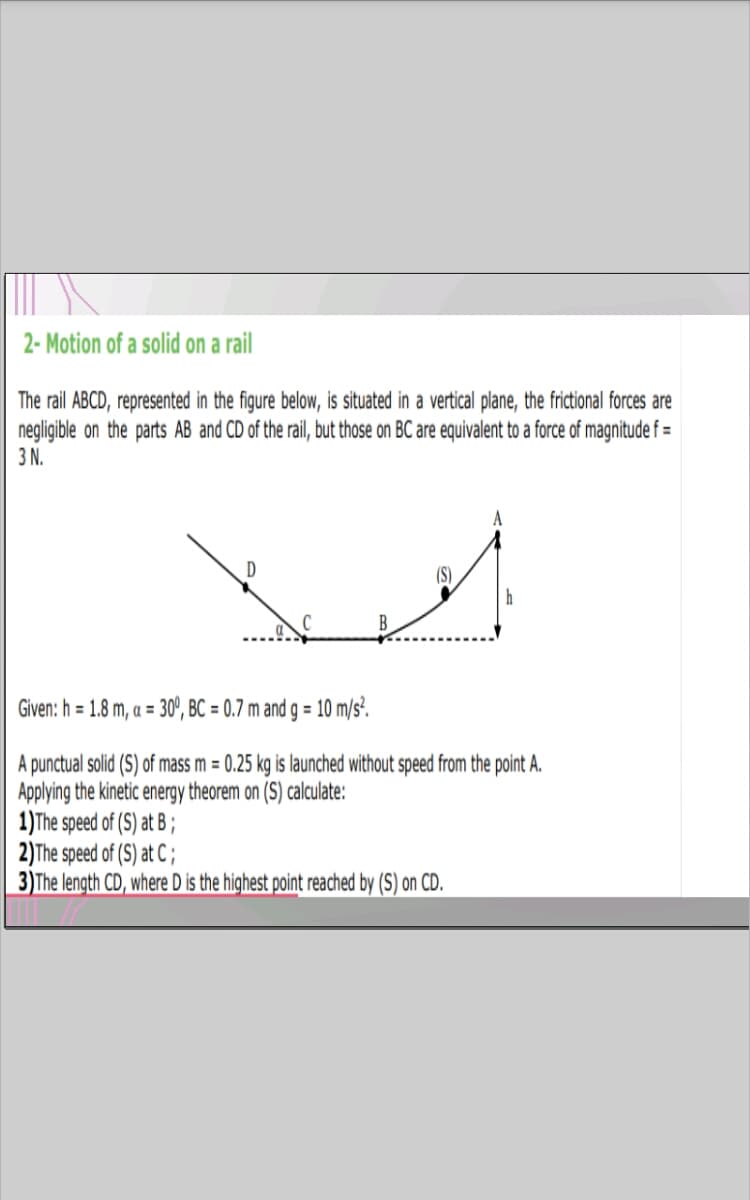The rail ABCD, represented in the figure below, is situated in a vertical plane, the frictional forces are negligible on the parts AB and CD of the rail, but those on BC are equivalent to a force of magnitude f = 3N. D B Given: h = 1.8 m, a = 30°, BC = 0.7 m and g = 10 m/s². A punctual solid (S) of mass m = 0.25 kg is launched without speed from the point A. Applying the kinetic energy theorem on (S) calculate: 1)The speed of (S) at B ; 2)The speed of (S) at C ; 3)The length CD, where D is the highest point reached by (S) on CD.
The rail ABCD, represented in the figure below, is situated in a vertical plane, the frictional forces are negligible on the parts AB and CD of the rail, but those on BC are equivalent to a force of magnitude f = 3N. D B Given: h = 1.8 m, a = 30°, BC = 0.7 m and g = 10 m/s². A punctual solid (S) of mass m = 0.25 kg is launched without speed from the point A. Applying the kinetic energy theorem on (S) calculate: 1)The speed of (S) at B ; 2)The speed of (S) at C ; 3)The length CD, where D is the highest point reached by (S) on CD.
Physics for Scientists and Engineers, Technology Update (No access codes included)
9th Edition
ISBN:9781305116399
Author:Raymond A. Serway, John W. Jewett
Publisher:Raymond A. Serway, John W. Jewett
Chapter12: Static Equilibrium And Elasticity
Section: Chapter Questions
Problem 12.1OQ: The acceleration due to gravity becomes weaker by about three parts in ten million for each meter of...
Related questions
Concept explainers
Rotational Equilibrium And Rotational Dynamics
In physics, the state of balance between the forces and the dynamics of motion is called the equilibrium state. The balance between various forces acting on a system in a rotational motion is called rotational equilibrium or rotational dynamics.
Equilibrium of Forces
The tension created on one body during push or pull is known as force.
Question

Transcribed Image Text:2- Motion of a solid on a rail
The rail ABCD, represented in the figure below, is situated in a vertical plane, the frictional forces are
negligible on the parts AB and CD of the rail, but those on BC are equivalent to a force of magnitude f =
3 N.
(S)
B
Given: h = 1.8 m, a = 30°, BC = 0.7 m and g = 10 m/s².
%3D
A punctual solid (S) of mass m = 0.25 kg is launched without speed from the point A.
Applying the kinetic energy theorem on (S) calculate:
1)The speed of (S) at B ;
2)The speed of (S) at C ;
3)The length CD, where D is the highest point reached by (S) on CD.
Expert Solution
This question has been solved!
Explore an expertly crafted, step-by-step solution for a thorough understanding of key concepts.
Step by step
Solved in 3 steps with 3 images

Knowledge Booster
Learn more about
Need a deep-dive on the concept behind this application? Look no further. Learn more about this topic, physics and related others by exploring similar questions and additional content below.Recommended textbooks for you

Physics for Scientists and Engineers, Technology …
Physics
ISBN:
9781305116399
Author:
Raymond A. Serway, John W. Jewett
Publisher:
Cengage Learning

College Physics
Physics
ISBN:
9781285737027
Author:
Raymond A. Serway, Chris Vuille
Publisher:
Cengage Learning

Physics for Scientists and Engineers with Modern …
Physics
ISBN:
9781337553292
Author:
Raymond A. Serway, John W. Jewett
Publisher:
Cengage Learning

Physics for Scientists and Engineers, Technology …
Physics
ISBN:
9781305116399
Author:
Raymond A. Serway, John W. Jewett
Publisher:
Cengage Learning

College Physics
Physics
ISBN:
9781285737027
Author:
Raymond A. Serway, Chris Vuille
Publisher:
Cengage Learning

Physics for Scientists and Engineers with Modern …
Physics
ISBN:
9781337553292
Author:
Raymond A. Serway, John W. Jewett
Publisher:
Cengage Learning

Principles of Physics: A Calculus-Based Text
Physics
ISBN:
9781133104261
Author:
Raymond A. Serway, John W. Jewett
Publisher:
Cengage Learning

Physics for Scientists and Engineers
Physics
ISBN:
9781337553278
Author:
Raymond A. Serway, John W. Jewett
Publisher:
Cengage Learning

College Physics
Physics
ISBN:
9781938168000
Author:
Paul Peter Urone, Roger Hinrichs
Publisher:
OpenStax College